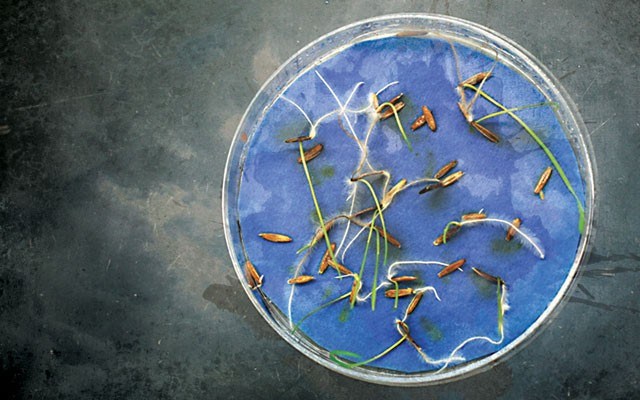After months of searching, Heather Schneider was beginning to despair. The University of California (UC) Santa Barbara postdoc had been scouring drought-ravaged Southern California for a rare yellow wildflower called the seep monkeyflower, a water-loving native perennial that occupies seeps and small pockets where moisture accumulates. Her goal: to gather some of its seeds and whisk them off to a U.S. Department of Agriculture seed storage facility in Fort Collins, Colorado.
"I literally had people laugh at me when I said I was looking for that species," Schneider says. During the three years she spent, from 2013 to 2015, collecting seeds from around the West, California consistently had lower-than-average rainfall. The dry conditions made it nearly impossible to find the damp environment that Mimulus guttatus calls home. Eventually, however, Schneider found a few specimens in Northern California and in other states, and was able to deposit their seeds in Project Baseline's minus 18-degree Celsius freezer.
Until now, most institutional seed-banking initiatives have essentially mimicked Noah's Ark, stockpiling an array of wild species or crop varieties for conservation purposes, to be used only in the event of ecological catastrophe. Project Baseline, however, wants its inventory to be used for research. The hope is that its more than five million seeds from 60-plus species can provide future researchers with a genetic snapshot, so that they will be able to identify changes as evolutionary responses to climate change.
Seeds have been gathered from across the nation, but Western species rank high in the project's inventory: Joshua trees, California poppies and purple needlegrass, for example, as well as lesser-known varieties like the seep monkeyflower and elegant clarkia. The collection process is now complete, and, given continued funding, Project Baseline's seed bank should be open for business by 2020. By then, evolutionary changes could begin to be apparent. Researchers can withdraw seeds from the collection and cultivate them for comparison to specimens that have continued to evolve in the wild. They can then study the changes each species exhibits over time.
The project provides a level of experimental control that evolutionary scientists are rarely afforded. In the past, for instance, the absence of well-chronicled baselines has hampered research designed to monitor how specific species have evolved, says Julie Etterson, an associate biology professor at the University of Minnesota Duluth and the lead principal investigator for the project.
Scientists have often had to rely upon "happy accidents," she says, in which researchers stumbled across a few handfuls of old seeds gleaned from frozen Alaskan soils — or even, on occasion, from cleaning out their laboratories' refrigerators. "But we can do better than that," says Etterson. "Instead of being random and arbitrary, we can be really intentional."
With Project Baseline, Etterson and her colleagues can help researchers answer a wide range of questions, shedding light on the variables affecting a plant's ability to adapt to climate change. That requires intensive comparison between different species — common plants versus specialized local species, plants with long lifecycles versus those with short ones, plants that rely on live pollinators versus those pollinated by wind. Even invasive species like rapeseed and black mustard are included, so that researchers can determine whether climate change will enable so-called weeds to become even more dominant.
Researchers made sure that there was ample diversity within every species by drawing from 10 to 20 populations of each, sampling from Northern and Southern regions, as well as from both high and low elevations.
Complications such as drought and wildfire made it harder to find many plants. One collection site in Northern California was torched by a wildfire just 12 hours after Schneider obtained the seeds of two native wildflowers. In other cases, the need to obtain access and permitting slowed down the collection process. Occasionally, researchers finally reached a site only to find that the plants in question had already become locally extinct.
And relocating those species for future comparisons will likely be even more challenging, as the "novel climate regime" now taking hold disrupts their distribution, according to Susan Mazer, a UC Santa Barbara professor and the project's principal investigator in the West. In response, the project has focused on protected wilderness areas, where species are less likely to be impacted by human development.
Now it's up to the next generation of scientists to convert Project Baseline's inventory into a clearer understanding of how plants are responding to climate change. Worsening drought and other stresses are especially likely to leave a lasting imprint on the genetic composition of Western plants. That's why it's so important to preserve a snapshot of the present, right before what scientists expect to be a tumultuous period. "This is the calm before the storm," says Schneider. "Of course, they're always adapting, but they represent a unique point in time."
Former HCN intern Bryce Gray covers energy and the environment at the St. Louis Post-Dispatch in Missouri.




